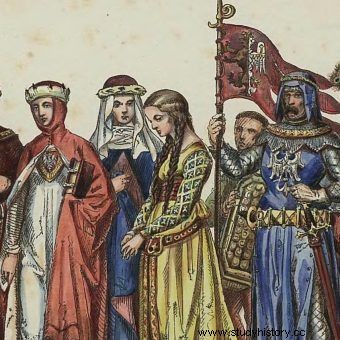
No portrait of Jadwiga Kaliska is known. Above, a plaque presenting court costumes from the turn of the 13th and 14th centuries by Jan Matejko. You can imagine that the Polish queen also dressed in a similar way
Jadwiga Kaliska, Jadwiga Bolesławówna (-1339) - Duchess and Queen of Poland from the Piast dynasty, born around 1270. She was the daughter of the district prince, Bolesław the Pious. By the decision of her relatives (after the premature death of her father), she was married to Władysław Łokietek, the swift and adventurous ruler of a part of Kujawy. When her spouse lost the rivalry for the Polish throne and the crown with Wenceslaus II, she was forced to hide in disguise for several years in a small town in Kujawy. After her husband's return, she played an important role in suppressing the rebellion of the Krakow bourgeoisie, remembered as the rebellion of the alderman Albert (1311-1312). In 1320 she was crowned Queen of Poland.
Queen Jadwiga Kaliska played a significant role in politics and had a significant influence on Władysław Łokietek. The husband even gave her his own seal, enabling Jadwiga to make key decisions on her own. She enjoyed the grace of the papal curia, confirmed by special privileges, and after the death of Władysław Łokietek, she greatly contributed to the building of the Hungarian party at the Kraków court.
When her son Casimir the Great came to power, she openly opposed the coronation of her daughter-in-law, Aldona Anna Giedyminówna, who came from Lithuania. She argued that there could only be one queen in the country - herself.
She efficiently managed the land of Nowy Sącz, given to her as a widow's binding, and then she joined the local convent of Poor Clares. At the end of her life, she planned a trip to Hungary, to her daughter and the local ruler, Elżbieta Łokietkówna. She died before this plan could be realized.
